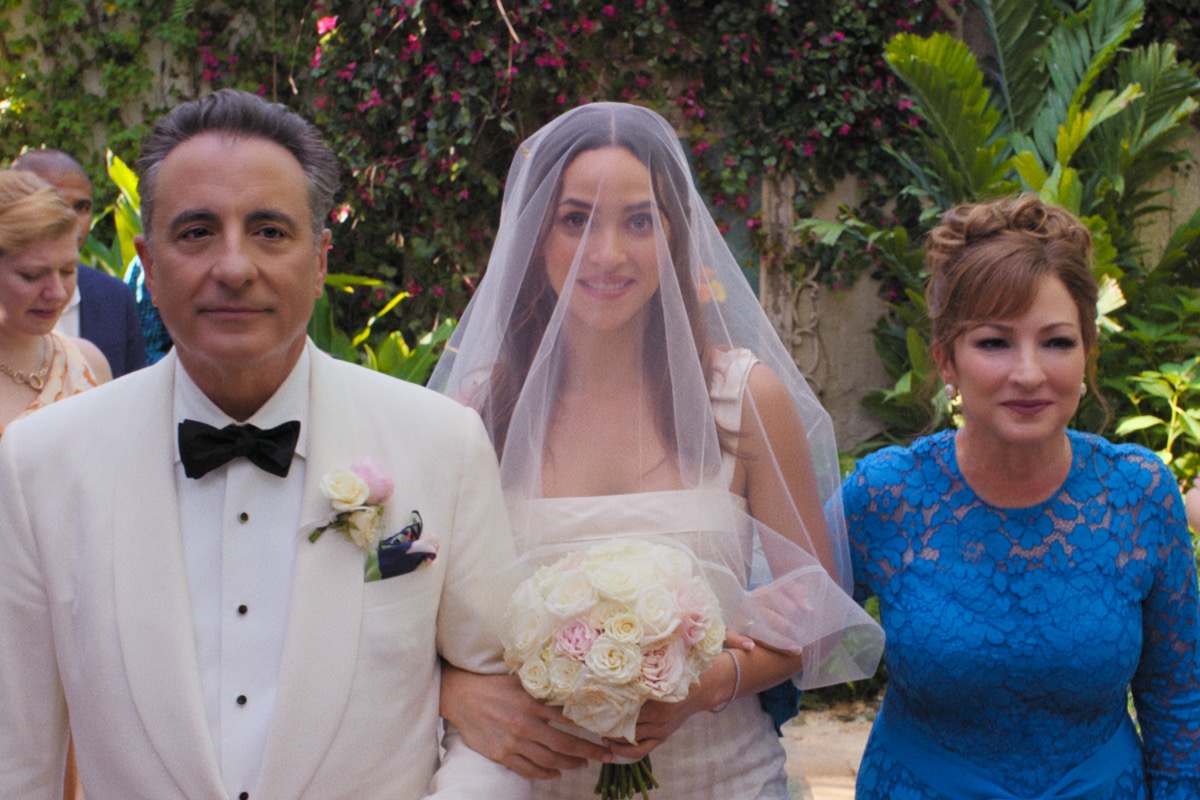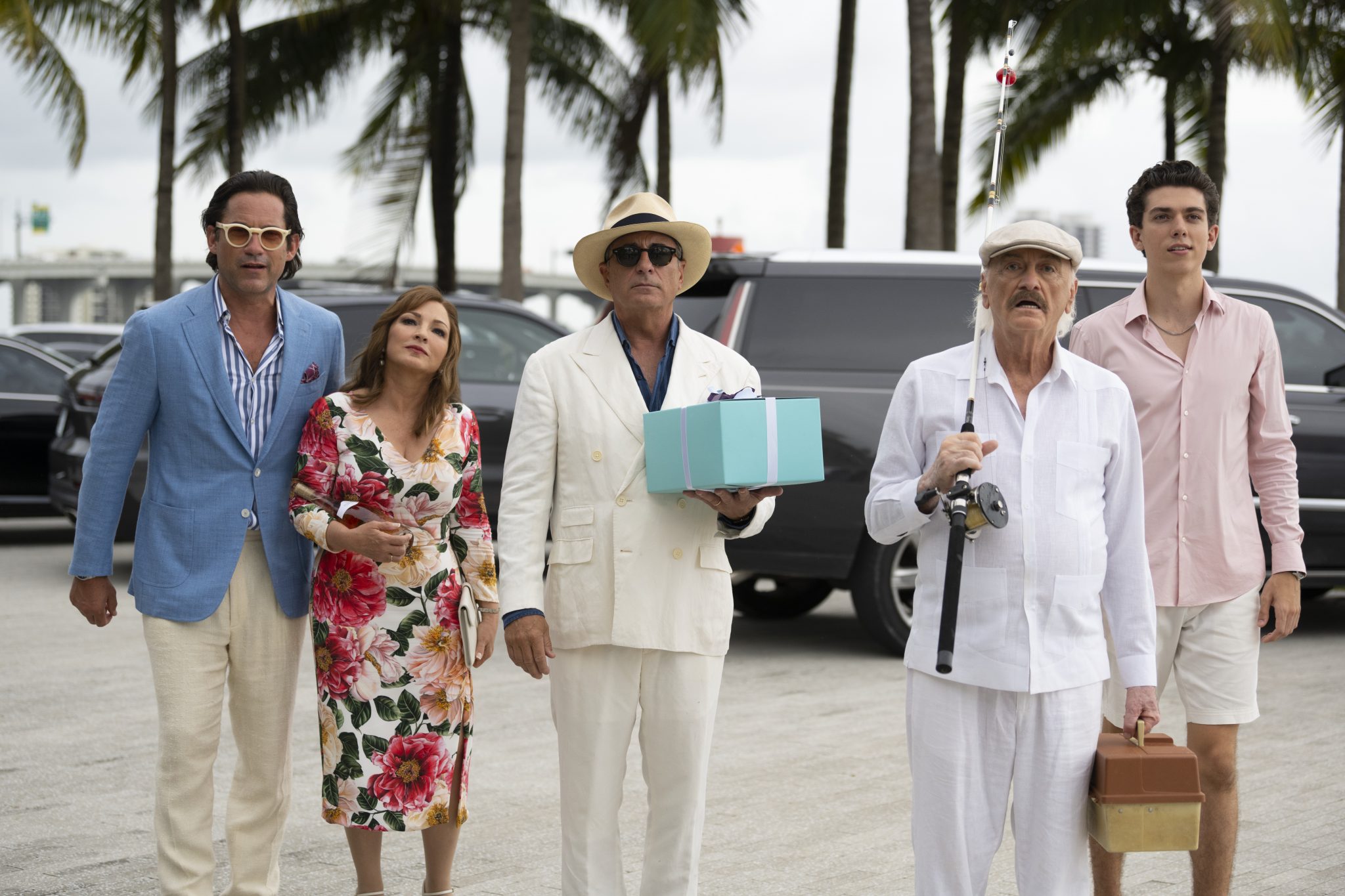

From left, Andy Garcia as “Billy,” Adria Arjona as “Sofia,” and Gloria Estefan as “Ingrid” in Warner Bros. Pictures’ and HBO Max’s ‘Father of the Bride’ (Courtesy of Warner Bros. Pictures)
I don’t want to be defined by the struggle.
I’m not saying that the struggle isn’t an important part of understanding Latinx identity —it is— it’s just not all that we are. And Hollywood is finally coming to the realization that our lives are not all deportations, drug violence, and poverty.
Just check out HBO’s recent and much-watched Father of the Bride. It tells the story of two Latinx families as aspirational and aspirationally American. While there are problems with the movie —does their privilege come from their fair skin? the film doesn’t say— it is nice to see Latinx people headline a successful, classic film—especially one that punches up at whiteness.
Just look at the wedding planner character. The script by Matt Lopez plays her ignorance for laughs. She gets schooled for not understanding cross-national Latinx differences, speaking terrible Spanish, and generally not understanding the traditions of either the bride or groom’s family.
Then there’s the moment where the two patriarchs spar. Before it devolves into near fisticuffs, Andy Garcia’s Billy Herrera calls Pedro Damián’s Hernán Castillo a “whitexican.” Now, this is silly since both men are fair-skinned and can clearly pass for white. But that “white” is an insult among these rich Latinos is notable.
In Father of the Bride, siding with the colonizer is a negative, not a point of pride.


From left, Adria Arjona as “Sofia” and Isabela Merced as “Cora” in Warner Bros. Pictures’ and HBO Max’s ‘Father of the Bride’ (Courtesy of Warner Bros. Pictures)
And this is a story of our elites. Those two fathers are fighting over who gets to pay for what? I mean, at first, Billy is worried Diego Boneta’s Adan is too poor for his daughter and then, later, too rich. That’s such a U.S. sentiment, where the only right amount of money is the amount you have—less is backsliding and more is unseemly.
Class consciousness also shows up with how the film takes pains to say its subject’s wealth came (I’d argue at least in part) from hard work. Billy is fond of retelling how he came from Cuba with nothing and had to work as a valet as part of pulling himself up by his proverbial bootstraps to become the successful architect we see now.
And we do learn that while the Castillos are one of the richest families in Mexico (which itself is practically an oligarchy), Hernán grew their business through hard work. Their story, we are asked to believe, is one of striving, that classic U.S. value.
Now, I know it’s a trick of capitalism to get us to identify with the ruling class as if someday all the current valets will be on the covers of white-collar industry magazines. Clearly, that’s not how it works, and the Herreras’ white Cubaness must have helped with their rise, although the film doesn’t interrogate that.
Instead, we see their Latinidad through a lot of stereotypical markers: Billy drives a classic car (like he never left Cuba!), and the Herreras drink mojitos, play dominoes, and watch boxing. On the Mexican side, carne asada and mariachis are the Castillos’ cultural markers.


From left, Enrique Murciano as “Junior,” Gloria Estefan as “Ingrid”, Andy Garcia as “Billy,” Ruben Rabasa as “Tío Walter,” and Sean Patrick Dawson as “Junior” in Warner Bros. Pictures’ and HBO Max’s ‘Father of the Bride’ (Courtesy of Warner Bros. Pictures)
And yet, it is nice to have a Crazy Rich Asians-style film with Latinx characters. It’s nice to see folks with those markers make it, especially when you add in how they navigate Spanish fluency, traditions, and family.
The true arc of the film is Billy’s development. As much as he likes to repeat the story of his hardscrabble past, his immigration story is keeping him from enjoying the present. He’s out of touch with where he really is in life, in terms of his wealth, age, and relationships. And that trauma has consequences: his wife is ready to leave him and he’s blocked from building a meaningful relationship with his youngest daughter.
Now clearly, still thinking of yourself as poor and being stuck in the work-above-all mindset is not the biggest of tragedies, and Father of the Bride doesn’t play it as such. Instead, it gives us a gentle, Latinx film where everyone, even the wedding planner, gets to learn and grow, bathed in a flattering golden light. It’s Nancy Meyers interior design meets Gentefied casting.
With Father of the Bride, Latinx people get the Hollywood treatment: we’re all thin, rich, and beautiful. What could be more imperfectly American than that?
***
A writer and activist, Cristina Escobar is the co-founder of latinamedia.co, uplifting Latina and gender non-conforming Latinx perspectives in media. She’s a member of the Latino Entertainment Journalists Association and writes at the intersection of race, gender, and pop culture. Twitter: @cescobarandrade


